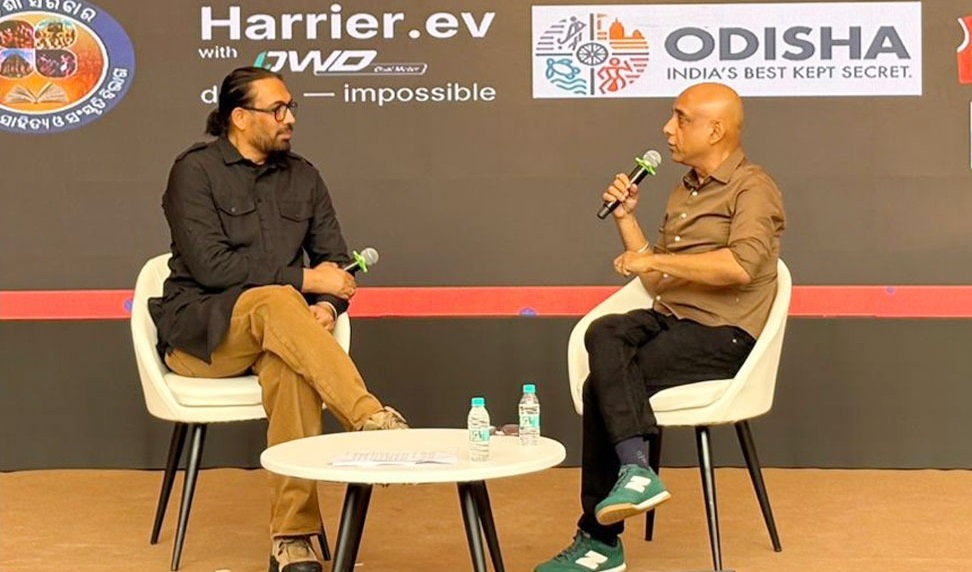New Delhi: Session 6 at the Ekamra Sports Literature Festival unfolded with an intensity that few in the audience were prepared for. What began as a literary platform soon turned into a deep excavation of memory, crime, and unresolved trauma. The conversation centred around Gunned Down: The Murder of an Olympian, Sundeep Misra’s fifth and arguably most powerful book—one that ventures into the rarely explored world of sports crime writing in India. Joining him on stage was veteran crime reporter and author Jupinderjit Singh, whose work Who Killed Moosewala? has made him one of Punjab’s most respected investigative voices. Together, they took the audience into a world where fame provides no protection, where legends fall, and where justice becomes an elusive dream.
The session moved far beyond headlines and archive clippings. It turned into a chilling yet deeply humane exploration of legacy, violence and the stories that refuse to fade. As the applause settled, Jupinderjit took the mic, beginning with a revealing confession—one that set the tone for the next hour. He recalled being handed Misra’s book for review and feeling a sharp pang of professional jealousy. “I am a crime reporter,” he said, “I am supposed to write such an investigation… and he beat me to it.” But beneath that envy was admiration for a sports journalist who took on a case that had remained buried for decades: the unsolved murder of three-time Olympic medalist and penalty corner titan, Prithipal Singh.
The Olympian Nobody Saved
For many in Punjab, Prithipal Singh was a name associated with hockey glory—fearsome, talented, awe-inspiring. Few, however, knew the intricate, tragic details of his final years or how violently his life came to an end. Even fewer realised that no one has ever been convicted for his murder. Jupinderjit reminded the audience that in a state long accustomed to grenades, gang wars, cross-border drug drops and daily violence, the killing of an Olympian should have sparked national outrage. Instead, it faded into the background. It took someone like Sundeep, who had spent decades documenting sport rather than crime, to bring the truth back into sharp focus.
Sundeep’s connection with Prithipal began not in a newsroom, but in childhood. He recalled sitting with his father playing a favourite game: drawing up the top ten sportspersons in various disciplines. When hockey came up, his father gently pointed out a missing name—Prithipal Singh. Sundeep had never seen him play, never read about him, and yet that name refused to leave him. Years later, while covering hockey from 1989 onward, he encountered older players who spoke with awe of Prithipal’s raw power, precision, and towering presence. But it was not until 2011–12 that Sundeep decided the story demanded a full-length book, not a column. He wanted to go beyond the matches and medals and find out what really happened on the day Prithipal was murdered.
A Story Few Wanted to Tell
Writing the book was not difficult, Sundeep said—it was “extremely challenging.” Families did not want to talk, former players called him controversial, and the police system offered him nothing but missing files and closed doors. Even among old teammates, the silence around Prithipal’s personality was striking. They were eager to praise his game, but hesitant to discuss the man behind the stick. The fear was palpable. Some worried that the case could reopen and drag their names back into the shadows of events they had tried to forget.
The real challenge, Sundeep emphasised, was not reconstructing matches or reputations. It was finding out who killed him. That search took him across borders—Canada, the United States, Malaysia, the UK, Europe. He spent years chasing leads that dried up, knocking on doors that stayed shut, until finally, in a moment he describes as “the closure point,” he found the breakthrough. It still took seven to eight years to complete the book.
The Campus Where Death Was an Open Secret
To understand the murder, Sundeep told the audience, one must go back to Punjab Agricultural University (PAU) in the late 1970s and early 1980s. It was a turbulent period. Punjab was slipping towards the decade of militancy, but Sundeep was categorical: this murder was not linked to terrorism. It was rooted instead in campus politics, personality clashes, and the rise of the Punjab Students Union (PSU).
Prithipal was a rigid, uncompromising administrator—a man who expected discipline, respect, and obedience. He had served as Dean of Student Welfare and Director of Sports at PAU. Students either admired him intensely or despised him deeply. According to Sundeep’s conversations with PSU members, many felt suffocated by his authoritarian style. They did not deny his greatness on the field—he was, after all, India’s top scorer in three consecutive Olympics, an accomplishment no Indian player has replicated. But as an administrator, he struggled to understand a younger generation driven by student politics, activism, and identity.
The first major flashpoint was the abduction and murder of student leader Prithipal Singh Randhawa in 1979. Rumours spread that the dean’s strict policies had played a role, but there was no evidence. Time passed, memories dulled—and then came 1983.
That year, another charismatic student leader, Pyara Singh—a national-level handball player and university topper—was killed in a violent hostel clash. Though the exact circumstances remain disputed, the PSU believed that Pyara’s death was a direct result of Prithipal’s aggression towards student leaders. This was the tipping point. A meeting was held. A decision was made. The PSU vowed that within 30 days of Pyara’s bhog ceremony, they would kill Prithipal.
Everyone knew. The administrators knew. The police knew. The students knew. And most tragically, Prithipal himself knew.
A List in the Pocket
Sundeep revealed that Prithipal carried in his pocket a list of those he believed were plotting to kill him. When the body was taken for postmortem, that list was recovered. But within a week, it vanished from the police files. When the case reached court, the officer who had recovered the paper denied its existence. The university denied its existence. It became one more disappearing document in an unresolved case.
To Sep, this detail remains one of the most extraordinary elements of the entire investigation: a murder victim who carried the names of his probable killers—and a justice system that failed to act even with that knowledge.

The Day Everyone Expected a Murder
The threats were so clear that police assigned him three security guards and begged him to stop using his motorcycle. But Prithipal refused to change his routines. “No one in this world can kill me,” he is quoted as saying—an expression of Punjabi defiance, or perhaps a fatal miscalculation.
On the day he died, he drove to Tappe House inside the campus. He parked the bike. And the gunmen stepped out of the shadows. Within minutes, the legend of India’s penalty corner powerhouse lay on the ground, shot dead in broad daylight on a campus that had been expecting his murder.
The Killer Who Spoke
One of the most chilling revelations of the session—and of the book—is that Sundeep met the killer. Not once, but twice. First through a go-between in Calgary, then face to face in Toronto. The man took Sundeep’s phone, made him switch it off, and spoke about the planning, the atmosphere, the hatred.
When Sundeep asked him what he would do if Prithipal appeared today in the same circumstances, the man replied without hesitation: “I’ll pump in six more bullets.” Four decades later, the hatred was still alive.
Later, Sundeep visited him again in Patiala, where the man served him tea and Good Day biscuits. In that ordinary domestic setting, Sundeep asked: Did you kill him? And again came the chilling reply: “No. But if I get the opportunity, I’ll shoot him again.”
Perhaps the most surreal moment came when the killer attended Sundeep’s book launch in Chandigarh, sitting quietly at the back. Sundep recognised him. The audience remained unaware.
A Story of Loss, Legacy and Lessons That Came Too Late
Despite the exhaustive research, Sundeep insists that his book cannot change Indian hockey. It cannot fix what was broken. The loss of Prithipal, he believes, was a death blow to India’s penalty corner legacy. His technique, intuition, and scoring consistency could have shaped generations. But his inability to adapt to the campus politics of a changing Punjab created fissures that turned into fatal fault lines.
Sundeep resists reducing him to a martyr or a villain. Instead, he paints him as a brilliant, flawed man who misread youth, misread the times, and underestimated the power of collective resentment. The tragedy of his death is doubled by the tragedy of what Indian hockey lost in the process.
Unanswered Questions and the Weight of Silence
More than forty years have passed since that day in 1983. Punjab has changed, politics has shifted, militancy has ebbed and resurfaced in new forms. But the murder of one of India’s greatest hockey players remains unsolved. No convictions. No closure for the family. No institutional memory in sporting bodies. Only a story that slipped into silence until one journalist decided it needed to be told.
As the session ended, the audience sat in a mixture of awe and unease. What they had just witnessed was not just a literary discussion—it was a confrontation with history, with failings of justice, with the darker side of fame that leaves heroes unprotected. Sundeep and Jupinderjit had opened a door into a world where sport meets crime, where legends meet mortality, and where stories wait decades for someone to write them down.
The applause that followed was long, heavy, and thoughtful. Because in remembering Prithipal Singh, the festival had also remembered the cost of forgetting.





